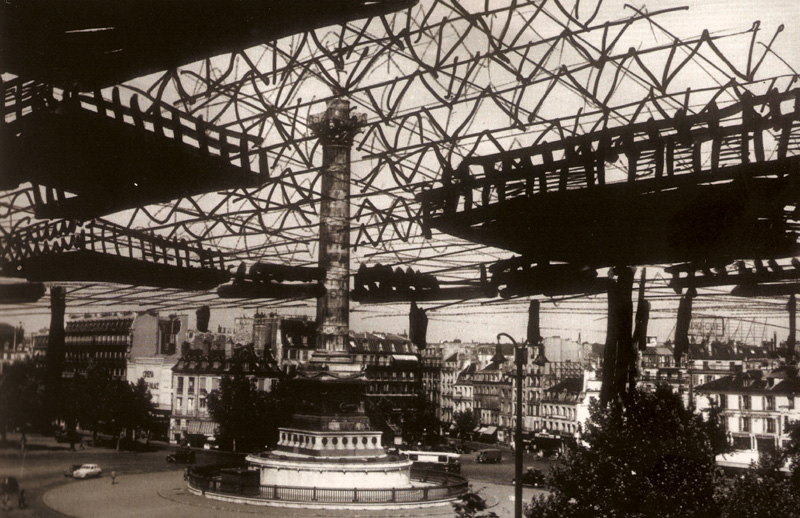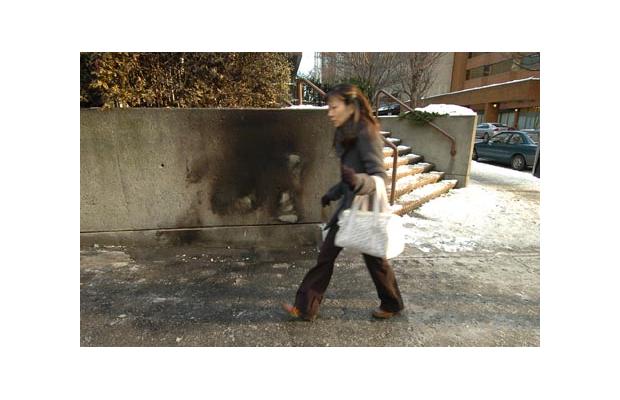“What new books might we write, if we could learn to use objects and spaces, buildings and bodies…to make architecture from words on a page?” – Shelly Jackson
This question has guided my deliberations on how exactly to go about doing a final project for this course. I knew I wanted to make a narrative, and one that tangibly interfaced with more than just sheets of paper. I wanted to use the city, and all the facets of its infrastructure not only as a place of radical fantasy, but as a material thing in and of itself. I wanted to write on it and with it – to throw fragments of a narrative across sidewalks and along the walls of buildings, to use the city’s own syntax of doorways and stairwells and multi-level car-parks, to collide text and space in a way that figures reading as a physical praxis. I’d then map it – the narrative – and chart it through more abstract, fantastic and parallel landscapes – digital landscapes, imagined geographies – all woven together as an elaborate hypertext, where the end links to the beginning in a paradoxical teleology of infinite regress.
After running through this naive and probably over-ambitious, under-developed scenario in different ways, it’s finally been subsumed as a preamble to a project that may prove to be more grounded, comprehensible and, most importantly, doable.
Specifically, my ideas began to change as I fixated more on graffiti as a primary mode of displaying the project. The physical act of superimposing an image, or in this case a text-based narrative, over a preexisting surface seemed apt considering the amount of work we’ve looked at this term that takes up collage as means of revising and re-conceiving the urban landscape.
I wanted to work with the concept of the overlay through graffiti, and realized the most direct way of achieving this would be to actually post the graffiti onto walls, along the lines of swoon or or Shepard Fairey’s Obey (/Obama) posters. I considered writing short, site-specific stories and then gluing the pages in the location they narrate, with piles of looseleaf on the ground, as if the walls were shedding memories: A kid drawing pictures in chalk, careless fingers dragged across by passerby, a bloody fight, a hustler’s date, a drifter’s muttered lamentations…
It made me realize how there wasn’t necessarily a need for completely fabricated memories – that the city is already marked up with its own stories, with the ceaseless flow of people imprinting its own kind of graffiti. The street, the walls, the sidewalk are all documents.
This pulled at a memory of my own – of a news story that ran this past December, about a homeless woman who’d burned to death downtown inside a makeshift shelter, on the corner of Hornby and Davie street. She had lit some candles to keep warm, fallen asleep, and burned alive inside her shopping cart. The absurd, horrific story had almost as much affect as the photographs of the wall the woman had been lying against. It was stained black.
I was, and still am, morbidly fascinated by the mark – I had this impulse after reading the story to go downtown to see it, to touch the soot, to look. And now I ask myself what it was exactly that I wanted to see – it was the news article that gave me the background of the event, its context, location, and most importantly its narrative. I wanted to see the story, or a fragment of it, as manifest in its remains.
The stain itself is an ambiguous black mark, but the words I read in the paper, and the words I’m reading right now in blogs, forums, and international press all act as means of writing the corner of Hornby and Davie street. Specifically, the black mark outlines a territory for this aggregate narrative – a locus or site for the words describing it. I want to bring the story a new publicity though, by overlaying a compiled account of it from the public realm of the internet onto that of the street. Alternately, I want to tear away the concrete surface of the wall, to expose an imagined underlying narrative structure.
I’m going to fill the space marked off by the burns – an incomprehensible space considering the experience inscribed there – constructing a narrative to fit within the borders of a blackened, unknown territory. I’m going to fill it with a patchwork of words distilled from its coverage in a kind of textual catharsis, enabling the possibility of both an analytical and affective process of delineating or mapping the event through words.
There is a range of directions the critical component of the project could take. Materially, I want to explore changing notions of news-media – printing web content on blank newsprint to gesture at the ephemerality of stories like this, regardless of them being archived elsewhere. The conflict of public/private is pressing too, as is that of detournment/defacement. The idea of the memorial as a public installation is taken up, alongside a consideration of the materiality of words, the physicality of text and its ability to quite literally form monuments
But then there’s the question of what exactly science fiction has to do with it. I want to go about answering this question by fixating on the marginalized, alienated position of the the homeless woman, who had appeared in the city weeks earlier and was known only as “Tracey”. Her liminality is compounded by the strangeness and unfathomable nature of her death, and framed absurdly by the idea that Vancouver is one of the most livable cities on the planet. One journalist responded to circumstances of Tracy’s death and the poverty that defined her life by stating, poignantly, that “It is truly another world.”
It is this this idea of ‘other worlds’ that figures so prominently in science fiction, where a large part of the genre’s work consists re-imagining and conceptualizing alternate places, states and subjectivities. Considering the possibility that public art, and graffiti in particular, can function as a means of this engagement with and understanting of what could be considered other-world positions, may afford us, an audience of pedestrians/readers, an alternate standpoint. In effect, the installation could act as a means of shifting perspective towards the margins, centralizing the narrative of Tracey’s death by fixating on the site as itself a textual and narrative medium. What sense could be made of urban space and the people that inhabit it through a situated imagining of one moment in the city?



matt- just wanted to let you know (as i would like to know if i wrote something good) that i was really touched by your portrayal of the woman known as ‘tracey’ and her death. it was great to read such well articulated, reflective thoughts on your reactions to this woman, whose anonymous and entirely isolated death has, i think, really helped catalyze current anti-poverty campaigns being promoted in the city today. so yeah… thanks for this… i really saw her in an entirely new (and refreshingly unpolitical) light through your words.
Thanks Kat! I hope the installation actually works – just heard back that The Vancouver Sun might be able to supply some newsprint, which is exciting. I think the project doesn’t come off as being overtly political because of its personal nature, although hopefully the project will be able to do something useful with the intertwining of the two.